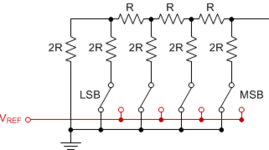Junus2012
Advanced Member level 5
Dear all,
For the conventional instrumentation amplifier circuit shown below, I made R4=R3 so I have the gain control reached by Av= 1+2R2/R1

I used to design multi-tapped resistor of R2 to have programmable gain amplifier. However, with many and fine gain setting it cost more switches for more taps, that I see in my design degrading the AC performance.
I would like to ask you if it is possible to use the 2-2R ladder for the gain setting to solve this problem and how to connect it in this InAmp
Thank you
Best Regards
For the conventional instrumentation amplifier circuit shown below, I made R4=R3 so I have the gain control reached by Av= 1+2R2/R1
I used to design multi-tapped resistor of R2 to have programmable gain amplifier. However, with many and fine gain setting it cost more switches for more taps, that I see in my design degrading the AC performance.
I would like to ask you if it is possible to use the 2-2R ladder for the gain setting to solve this problem and how to connect it in this InAmp
Thank you
Best Regards
